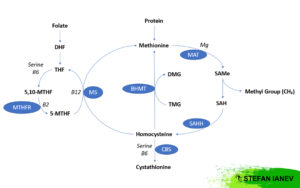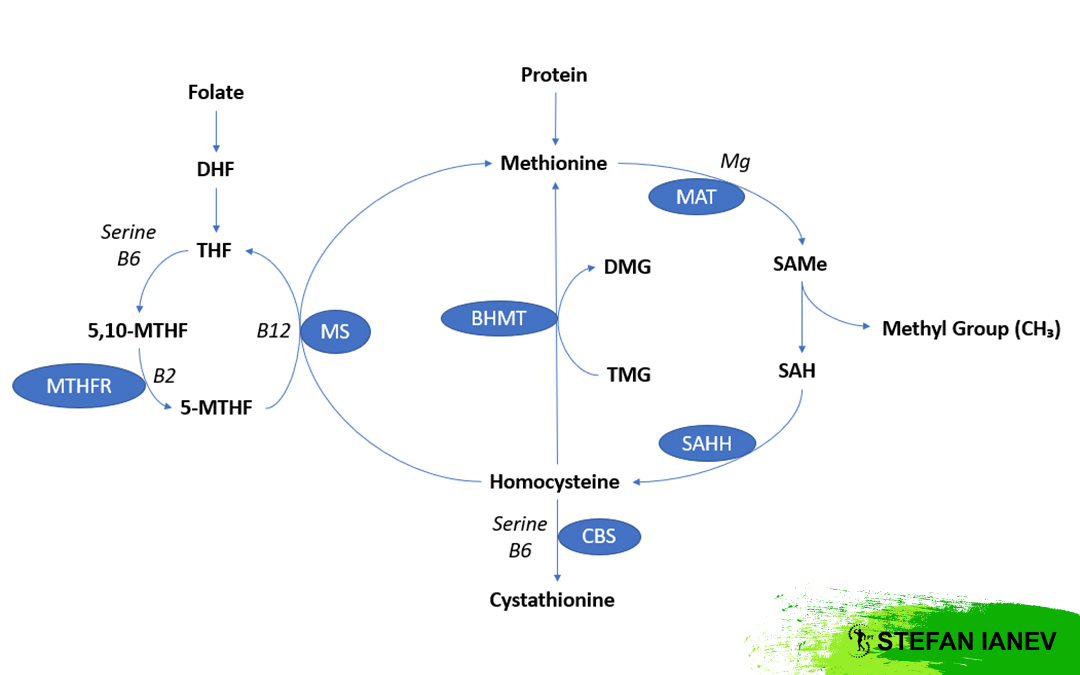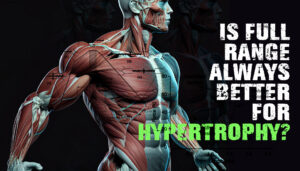In part 2 of this article we looked at how neurotransmitters are regulated by epigenetic processes such as DNA methylation.
If you recall methylation is the process of adding a methyl group to a protein, enzyme, or gene, which changes its function. This process occurs more than a billion times per second in the body and is responsible for hundreds of chemical reactions that are essential for physical and mental health.
The primary methyl donor in the body is SAMe which comes from the amino acid methionine. Once SAMe has donated its methyl group it’s transformed into SAH. If excess levels of SAH build up, methylation is slowed down.
With effective methylation SAH is converted to homocysteine. Homocysteine can then be recycled to methionine or converted to cystathionine. If there is not enough homocysteine there will be problems creating methionine. On the other hand, high homocysteine is a risk factor for heart disease.
There are several important enzymes and cofactors involved the methylation cycle. A simplified overview of the methylation cycle is shown below.

Figure 1 A simplified overview of the methylation cycle.
- Methionine is converted to SAMe by the MAT enzyme using magnesium as a cofactor.
- The majority of SAMe in the body is used to make creatine using arginine, glycine and ornithine as cofactors (not shown).
- SAH is converted to homocysteine by the removal of an adenosine group by the enzyme SAHH. Adenosine is then removed by the enzyme ADA which uses zinc as a cofactor (not shown).
- Homocysteine can be converted to cystathionine by the CBS enzyme using serine and B6 as cofactors. The cystathionine pathway is the primary source of cysteine, glutathione and other important antioxidants (not shown).
- Homocysteine can be recycled to methionine by the MS enzyme using 5-MTHF (methylated folate) and B12 as a cofactor. Folate is methylated by the MTHFR enzyme using serine, B6 and B2 as a cofactors.
- Homocysteine can also be recycled to methionine by the BHMT enzyme using trimethylglycine (TMG). TMG is synthesised from choline.
Most people have normal methylation and require a steady flux of all those nutrients for the methylation cycle to work properly.
However, due to genetic and environmental factors some people can be under or overmethylated. Under or hypomethylation occurs when there is not enough methyl or SAMe. Over or hypermethylation occurs when there is too much SAMe or homocysteine.
Undermethylation is generally a result of genetic SNPs involved in the methylation cycle. The most common SNP that most people have heard of is the MTHFR gene. However, that is only one of several genes involved in the methylation cycle. Having an MTHFR polymorphism doesn’t necessary mean someone is undermethylated.
Undermethylation can also be caused by insufficient protein intake, vitamin or mineral deficiency, excess histamine, and oxidative stress. Excess histamine depletes methyl reserves because histamine is deactivated by methylation. Oxidative stress depletes homocysteine because it pushes it down the cystathionine pathway to make more glutathione.
Overmethylation on the other hand is usually caused by impaired creatine or cystathionine synthesis which causes a build up of SAMe or homocysteine. It can also be caused by an arginine, glycine, or serine deficiency.
This is why it is important to know someone’s methylation status before prescribing targeted nutrient therapy.
Giving someone who is undermethylated therapeutic doses of nutrients that decrease methylation, or giving someone who is overmethylated therapeutic doses of nutrients that increase methylation can easily make them worse.
This is where it gets even more tricky, because certain nutrients like folate and choline that are involved in the methylation cycle and help increase SAMe levels in the body, have the opposite effect on DNA methylation.
Folate and choline increase DNA acetylation and decrease DNA methylation. As a result they increase expression of dopamine, serotonin and other neurotransmitter re-uptake transporters. Therapeutic doses should be avoided by undermethylators with low dopamine or serotonin levels.
On the other hand these nutrients would work great for overmethylators with excess neurotransmitter activity. Other nutrients which increase DNA acetylation and reduce DNA methylation include niacin, pantothenic acid, and DMAE.
Undermethylators on the other hand generally do best taking SAMe directly as well as supporting nutrients such as creatine, serine, TMG, methylcobalamin, B6, B2, magnesium, and calcium, which help the methylation cycle move along or reduce the need for methyl donors.
Giving the specific supplement recommendations is beyond the scope of this article as that would depend on a persons methylation status, size, nutrient deficiencies or excess, as well as their symptoms.
Keep in mind it’s possible to have a methylation imbalance and still have normal neurotransmitter levels, or to have normal methylation and have neurotransmitter imbalances, as there are other SNPs involved. However assessing methylation status is a good place to start.
The most direct way to assess methylation is with a SAM:SAH ratio blood test. This test is available through Doctors Data and requires a referring physician or specialist.
A more indirect way to assess methylation status is by using a whole blood histamine test. There is an inverse relationship between blood histamine and methyl in the body.
According to pioneering researcher Carl Pfeiffer and now Dr William Walsh of the Walsh Research Institute who has performed over 3 million lab tests in over 30,000 mental health patients and controls, the normal blood histamine range is between 40-70 ng/ml. Above or below this range may indicate under or overmethylation respectively.
Additional blood tests that may also be useful for determining methylation or biochemical imbalances include homocysteine, serum folate, B12 and B6, plasma zinc, and serum copper.
Homocysteine, folate, and B12 are all involved in the methylation cycle. Abnormalities in those markers can indicate abnormalities with the methylation cycle. B6 and zinc are also involved in the methylation cycle as well as being cofactors for neurotransmitter synthesis such as dopamine, serotonin, and GABA.
Copper on the other hand is involved in the conversion of dopamine to norepinephrine. Elevated levels can cause low dopamine and elevated epinephrine which can lead to anxiety, hyperactivity or depression. Elevated copper is generally accompanied by low zinc which increases genetic expression of metallothionine, an important enzyme in the detoxification of heavy metals.
As you can see biochemistry is complex. Everyone wants a simple answer like take this to fix that but it doesn’t work that way. This is why it’s important not to start messing around with targeted nutrients unless you know exactly what you are doing because it’s easy to make yourself worse.
A good starting point would be to get the blood tests listed above, and if something comes up, then consult with your doctor or a specialist to help normalize your biochemistry. Otherwise it’s much safer to just follow a balanced diet and avoid taking high doses of any nutrient.







